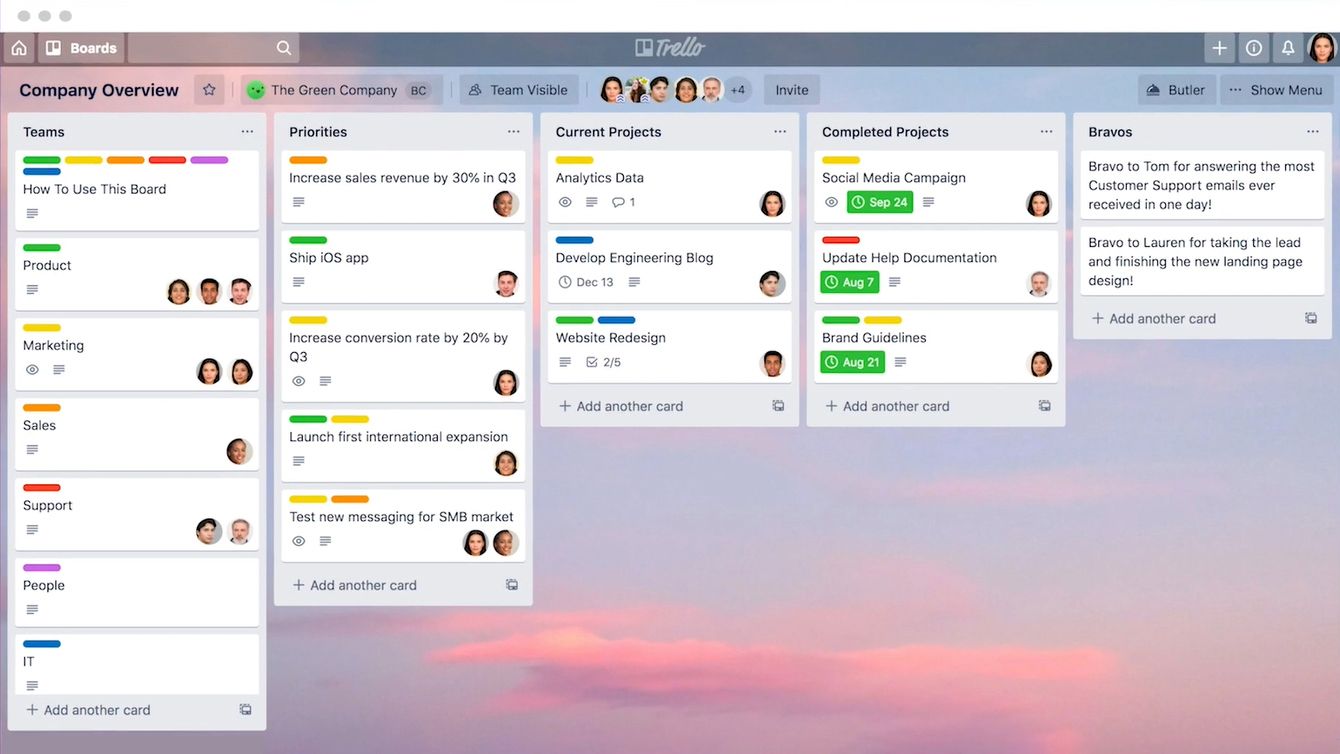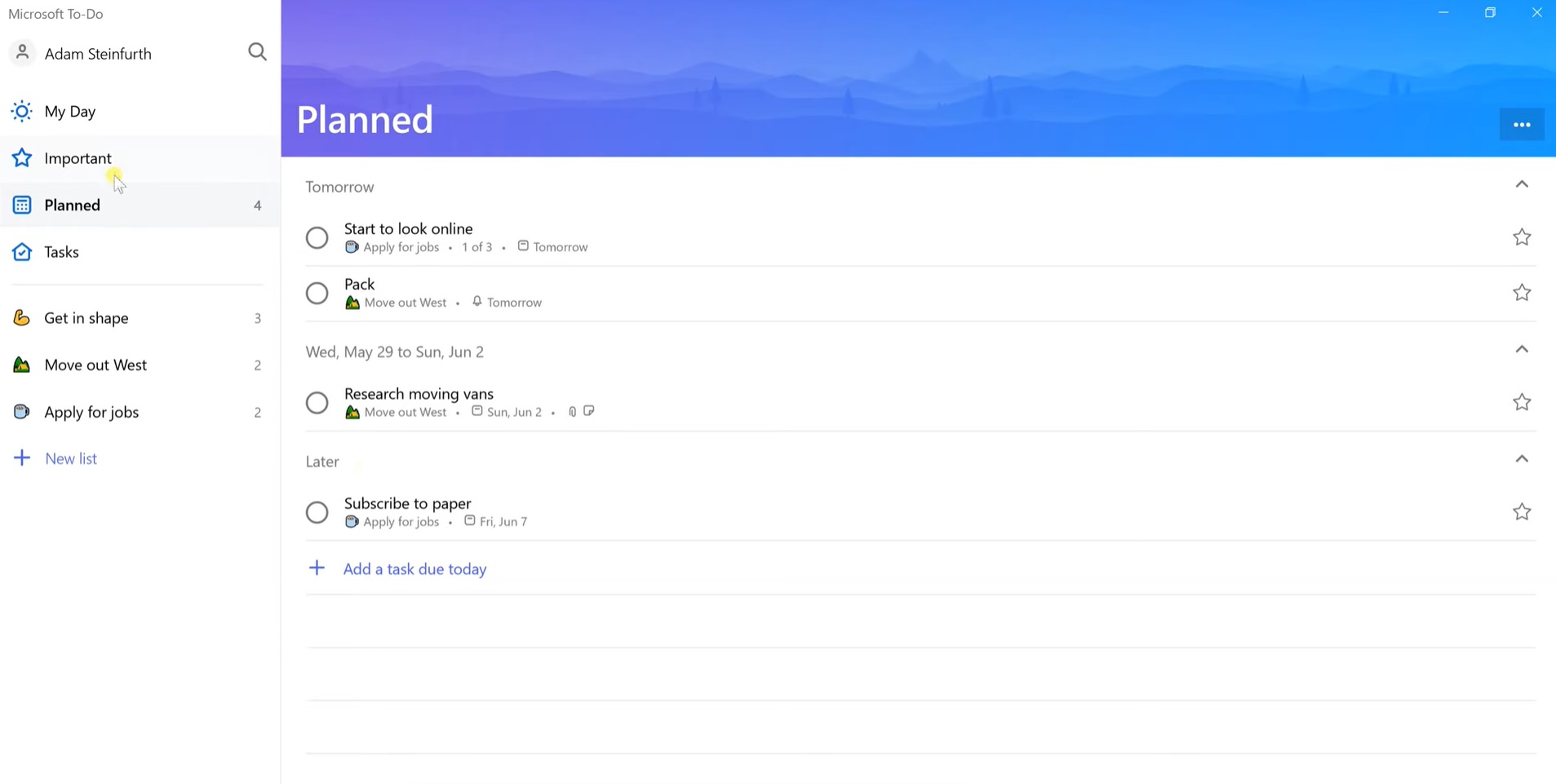Even before the Covid-19 pandemic hit, work-at-home setups have already been on the rise. Today, given the state of things, many companies that did not explore how their employees can work remotely and effectively are having trouble finding the right solution. Thus, many are checking out collaboration and project management software solutions like Trello and Wunderlist. This is because these are two of the most popular ones out there.
However, Wunderlist is now just retired, having folded into the Microsoft banner of products. So instead of doing a direct Trello vs Wunderlist comparison, we’ll do one with Wunderlist’s direct successor, Microsoft To Do.
So, in this article, we’ll help you decide which one is better for you. But first, before we give our official verdict. Let’s get to know each of the products.
Trello Overview
Trello is a project management and collaboration software solution popular among fans of the Kanban system. The Kanban system originated in Japanese manufacturing where project leaders move task cards from one column of a whiteboard to another to signify a change in job status. Each column can represent a phase or status. This way, managers and workers will be able to know where they are in their projects and what to prioritize.
Trello takes advantage of this system. Plus, it also has a calendar view that lays out all deadlines and milestones. In this way, everyone can keep up with important deliverables and schedules. With these easy-to-understand tools mixed with an intuitive interface, Trello is one of the most easy-to-use applications out there. What’s more, it has a free version that’s great for individual and small business use.
However, if you want to take your Trello usage to another level, we recommend that you sign up for its paid versions. One paid feature that extends the capability of Trello is what it calls its Power-Ups. This is just a term for integrations. For instance, you can make it work seamlessly with MailChimp and Zoho CRM. Also, through Power-Ups, you’ll have access to different automation tools, including Automate.io and even Slack. Furthermore, it makes its developer API available to users. Check out our Trello vs monday.com comparison guide, to learn how Trello compares with one of the industry’s best platforms.
Lastly, paid plan pricing starts from $9.99 per user per month.

Trello is a project management platform known for its Kanban boards.
Wunderlist Overview
Wunderlist was a popular list-based project management and collaboration tool. Like Trello, it has an intuitive user interface that is easy to understand and navigate. Plus, lists made on Wunderlist are also shareable to collaborators. This way, you can manage tasks and projects with teams.
However, we used the word ‘was’ because after being acquired by Microsoft, this free service will be discontinued this coming May 6, 2020. But, its successor, Microsoft To Do, with the backing of Microsoft, seems to provide better functionalities. In fact, according to our task management software analysis, it has already become one of the leading products on the market. Also, like any product under the Microsoft banner, it integrates seamlessly with other Microsoft products.
Thus, loyal Wunderlist users had to move to Microsoft To Do to keep their files syncing and updating. This is a bit of trouble for many. However, the Wunderlist team promised better features and capabilities as they were working on Microsoft To Do.
New features include My Day, which is a personalized daily planner and Suggestions that allows you to review important things. Other additional features include list themes, color-coded lists, and a dark mode. Plus, it retains the very important cross-platform syncing feature from Wunderlist.
Furthermore, just like Wunderlist and Trello, To Do let’s you assign tasks to your friends, colleagues, and classmates. It also enables you to add notes to your tasks and even attach files up to 25MB. Apart from these, there is also a subtask feature, and you can set up recurring dates. Lastly, it is free.

Microsoft To Do is a comprehensive to-do list app that will be replacing Wunderlist.
Trello vs Wunderlist Comparison
As mentioned, Wunderlist is now retired. In its stead is Microsoft To Do. So, instead of giving you the Trello vs Wunderlist comparison, we’ll give you our comparative analysis of Trello vs Microsoft To Do. Furthermore, we are going to use the following criteria: (1) feature set, (2) pricing plans and packages, (3) collaboration and integrations.
1. Feature Set
The first difference-maker when it comes to both products is that Trello is mainly web-based. On the other hand, Microsoft To Do is a hybrid. You can download it on your PC or Mac. And, you can also access its web-based version.
Another difference is that Microsoft To Do maintains the list-based interface it inherited from Wunderlist.
Thus, this limits the capability of the app per se. For instance, it doesn’t have a calendar view inside. However, you can have a calendar view when you integrate it with the official Microsoft Calendar application. In fact, To Do was designed not to be a standalone application. It was meant to work inside Microsoft’s digital architecture.
The availability of different views affect how we monitor, track, and understand productivity. Trello offers you this capability right within the app, thanks to its Kanban and calendar dashboards.
To Do offers the calendar view via integration with other Microsoft products. In itself, it can work fine for personal use. But, if you want to use it for business productivity, it is best used in coordination with other Microsoft products. So, if your team members are already using Office 365, To Do will seamlessly work within it.
Moreover, Trello offers automation features with rule-based triggers right within the app. Trello’s built-in automation AI allows you to skip the menial routines and work on actual productivity rather than managing a productivity platform.
To Do doesn’t have this built-in. You have to create them on Microsoft Flow. So, when it comes to built-in features, we can say Trello is more powerful. However, when you work within a Microsoft productivity environment, then To Do can be a better choice.
2. Pricing Plans and Packages
Firstly, To Do on Microsoft’s web-based platform Office.com is available for free. Also, its on-premise version is free on Microsoft Store. Thus, this is a perfect collaboration and project management tool for individuals who use Office.com or Office 365 already. This includes businesses that do too. Why? It is the perfect add-on to your overall productivity workflows.
However, because its features are limited by itself, people consider the more popular Trello as a substitute.
While Trello has a free plan, it is quite limited when it comes to managing more complex projects or collaborative tasks. If the free plan isn’t enough, you can switch to its Business Class plan for $9.99 a month per user, billed annually. This has larger file attachments available, more Power-Ups, a map view, more automation options, and advanced admin and security features.
Moreover, more features are available for large businesses on Trello’s $20.83 per month Enterprise plan. This is also billed annually.
Again, if we make a bare comparison between Trello and To Do, To Do seems to do better as it is free. Also, it seems to be the better choice when your business is already on Office 365. But, we couldn’t directly compare their pricing plans as one is more of like a module for a complete suite, and the other is a standalone product.
3. Collaboration and Integrations
If this were an old Trello vs Wunderlist comparison, Trello would easily win this criterion. But because of the shakeup and Wunderlist user migration, Microsoft To Do has a fighting chance. So, let’s get to it.
Obviously, collaboration is a very important criterion if not the most important one. And, when we compare their collaboration features, we think it is a hard decision to pick a winner. Why? First, collaboration is very easy to do with both platforms. Both are wonderfully designed and are very intuitive to use.
However, there are differences in how they are used best. And, your workflow processes will inform you of which application fits you best.
As mentioned, when your teams are heavy Microsoft Office users, then To Do is the likely app for you. On it, you can easily move from one Microsoft product to the other. You can send documents, media files, links, and many more. Just like Wunderlist, you can share lists and assign tasks and due dates to others. Plus, through its Office.com integration, you can co-author documents simultaneously too. This is a real-time collaboration feature that Trello doesn’t have built-in within its architecture. You have to connect it to other apps.
So, if your workflow is document-heavy, then maybe you should consider To Do. But, then again, connecting Trello to other apps is quite easy. In fact, you can use Trello with Office 365 or Office.com very easily. There are connectors available to notify people in Microsoft Teams whenever there are changes with cards and boards. So, you can use Trello with Office 365 seamlessly.
A Note on Integrations
Also, when you use SaaS products other than Office.com, Trello seems to be the better app. Microsoft To Do, in itself, is not the best standalone project management solution. It needs the help of other Microsoft products to increase its capabilities.
On the other hand, Trello is a complete project management app on its own. Moreover, you can even extend its use, thanks to its integrations, including one with the whole Office 365 suite. Other integrations or Power-Ups include automating content management software processes. Other popular integrations are Salesforce, Slack, MailChimp, Zoho CRM, and a host of others. So, if you are using a SaaS technology stack to manage your operations, we recommend Trello.
However, if you are using Office.com or Office 365 heavily, To Do is a better app to keep you within your Microsoft-based environment. Also, it is a great app, especially for Microsoft power users.
What is the better app?
If we are talking about being full-fledged project management software, the answer to this would be Trello. It is easy to use and is better suited to managing a small business than Microsoft To Do. Even when you make the old Trello vs Wunderlist comparison, Trello is just superior when it comes to feature set. Sure, To Do is an upgraded Wunderlist. But, as a standalone app, it is not as good as Trello.
However, when you have the whole Microsoft architecture behind you, and you are an Office user, To Do will help you organize your tasks easily. It integrates directly with other, apps such as Teams, Flows, Word, Excel, Skype, and many others under the Microsoft banner. With this, collaboration doesn’t just stop at managing projects. It extends to seamless document co-authoring capabilities.
Trello, however, is best used when you employ a SaaS technology stack. Thanks to its long list of integrations and automation features, you can extend its capabilities from a simple Kanban-based app to an easy enterprise management automation tool. With it, you can connect different seemingly disparate business processes from HR to CRM and finance.
So, what’s our official verdict? We believe it’s a close one. And, the answer is relative to your needs. For us, we think Trello is superior to Microsoft To Do. However, there may be ways where they can work together.
Lastly, you can compare project management software solutions if you think these two products don’t fit your preferences and workflow.
